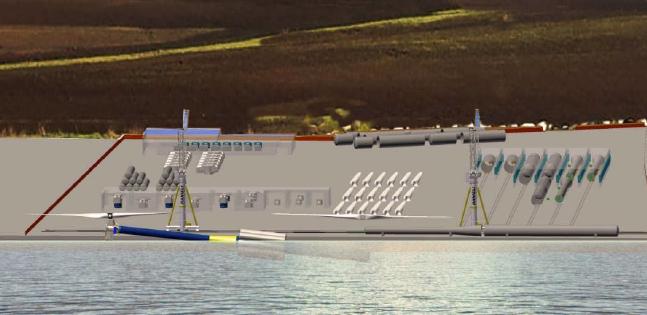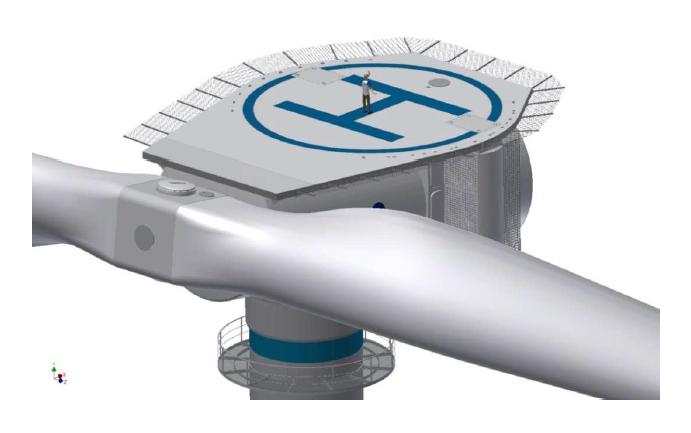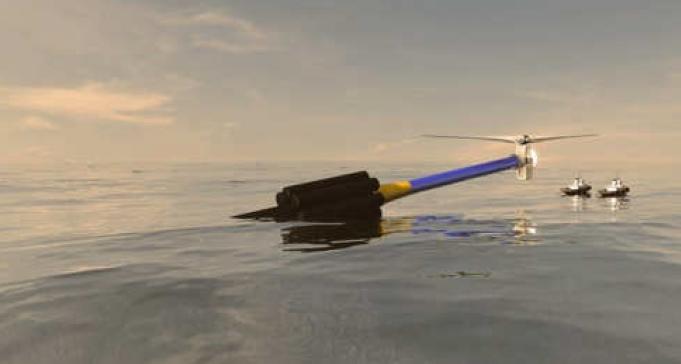Editor’s note: this article comes from Seawind Ocean Technology B.V.
Seawind B.V. (“Seawind”) has developed what it calls a “game-changing” solution for the offshore wind-energy market in a unique two-bladed wind turbine and offshore installation technology. Seawind’s combined engineering experience with two-bladed wind turbines is well over 120 years.
Seawind’s offshore wind turbine and installation technology can decrease today’s cost of offshore wind energy by over 50%. This cost reduction is based on:
- A durable lightweight turbine with a two-bladed rotor coupled to the shaft by an elastic coupling that decreases ultimate loads and fatigue on blades and the drivetrain in harsh ocean environments
- A simple wind turbine concept with proven and reliable components (Caterpillar principal) that removes the main component of failure in current wind turbines -the blade pitch mechanism. The introduction of an elastic rotor joint (teetering hinge as it is known in the helicopter industry) almost eliminates the gyroscopic forces and enables power control of the two-bladed rotor by turning the entire turbine head rapidly into or out of the wind (yawing).
- A launching method designed for shallow water (Seawind 6SW, up to 50m of water depth) and for deep water (Seawind 6DW, a floating turbine, up to 500m of water depth) which allows for assembly and launch of the complete unit from the pier into the water.
- A cost effective and simple self-installing process that only requires tugboats, no custom made, costly, or time-consuming installation vessels are needed.
- The ability to perform all maintenance onboard without the use of crane vessels.
- Higher accessibility to the turbine due to double access by sea and by air (helideck on top).
- A wind-turbine design that permits handling and exchanging heavy components without the use of crane vessels.
- A wind turbine lifetime of 25 years (compared to 20 years for traditional three-bladed wind turbines) along with the option of a lifetime extension program to reach 30 and more years of operation priced at manageable marginal costs
The Levelized Cost of Energy reduction is primarily attributed to:
- The reduction of the CAPEX by about 30%, lighter and simpler wind turbine
- The reduction of the OPEX by about 50% because of less fatigue and lower ultimate loads
- Reduction of financing costs by about 50% because of lower CAPEX & OPEX.
- A lifetime extension of Seawind’s offshore wind turbine by 10 and more years
compared to the lifetime of today’s three-bladed offshore wind turbines (20 years).
Two-bladed wind turbines for the offshore market
Fundamental engineering design principles dictate that two-bladed wind turbines can be made considerably lighter and simpler than even the lightest three-bladed turbines (not just through elimination of one rotor blade). Consequently, they are less expensive to manufacture, install, and decommission. For geometric reasons, two-bladed wind turbines are also easier to handle than heavier star-shaped three-bladed turbines. This characteristic supports the design of innovative installation methods for self-installing units which are not feasible with three-bladed wind turbines. The disadvantage of two-bladed wind turbines, a higher tip speed noise, is not a factor offshore.
The offshore wind sector is potentially more attractive than the onshore sector, because winds are stronger and offshore wind farms can be much larger than onshore wind farms, by a factor of 10 to100. The potential market for offshore wind power is well over 20,000 GW worldwide, which, at Seawind’s costs per MW installed, would be worth €50 trillion.
Seawind’s predecessor, Blue H Group Technologies Ltd, commissioned DNV GL for an offshore wind market study in 2009 (see below). Including China and Japan, not analyzed at the time of this study, the actual market size (GW) in the water depths indicated below is actually beyond 10,000 GW.
The magnitude and conformation of the world’s continental shelf leads to a reasonable assumption that the offshore wind market size between 1 and 30m depth is at least 10,000 GW. This supports a total worldwide market potential exceeding 20,000 GW.
The Seawind business model is based on:
- A showcase assembly and launching site in Poland to demonstrate the assembly and launching processes at the pier to future licensees. This plant will be operated by Seawind; will build out offshore wind farms in the Central and Eastern Baltic Sea, and will provide an operations and maintenance station to these wind farms.
- Licensing the complete offshore system by applying a small one-time license fee to regional licensees for exclusivity in a designated region (e.g. the Western Baltic Sea).
- A royalty for each offshore wind turbine installed with Seawind’s groundbreaking installation method, which brings the CAPEX of the installed wind turbine down to €2.25 million per MW compared from today’s cost of €3.7 million;
- A small performance fee from the revenues generated by the wind turbines during the lifetime of the offshore wind farm. After successful installation and operation of the Baltic Sea prototype in 2016 and industrialization through the Seawind demonstration offshore wind farm in 2017, Seawind plans to issue an IPO in 2018 at the Brussels StockExchange to provide an exit strategy for investors.
Regional licensees
The regional licensees have a fundamental function in Seawind’s business model.
Few companies in the world can engineer and manufacture large scale two-bladed wind turbines. Seawind has a long-standing expertise to design and simulate two-bladed wind turbines, coming from Glidden Doman’s experience in helicopter design and manufacturing. Glidden Doman is the last living helicopter pioneer, who built his first helicopter in 1947 in U.S. state of Connecticut. Since 1975, Glidden has been dedicated to the engineering of two-bladed wind turbines and is a cofounder of Seawind.
Seawind will initiate the production of its wind turbine nacelles in Poland with the largest Polish electro-mechanic industry. The nacelles have a weight of about 150 tons, a value of about $6 million, and can be shipped easily and cost effectively.
Seawind’s support structures are normal tubular structures, which can be manufactured by many companies around the world. The turbine blades feature a seamless modular assembly technology that can be transported in ordinary 40-ft shipping containers.
Due to the significant cost reduction of the installed offshore wind turbine coupled with its lower operational costs; Seawind is expanding the global market for offshore wind energy production in part by collaborating with regional licensees all over the world which will receive the major components from Seawind’s selected suppliers and produce the support structure locally.
A licensee needs only a pier, large crane, and for shallow water deployment, a concrete launching barge for which Seawind provides the drawings. Licensees will be able to serve a range of about 150 nautical miles from their pier.
Seawind Ocean Technology B.V.
www. seawindtechnology.com
Filed Under: News, Offshore wind







